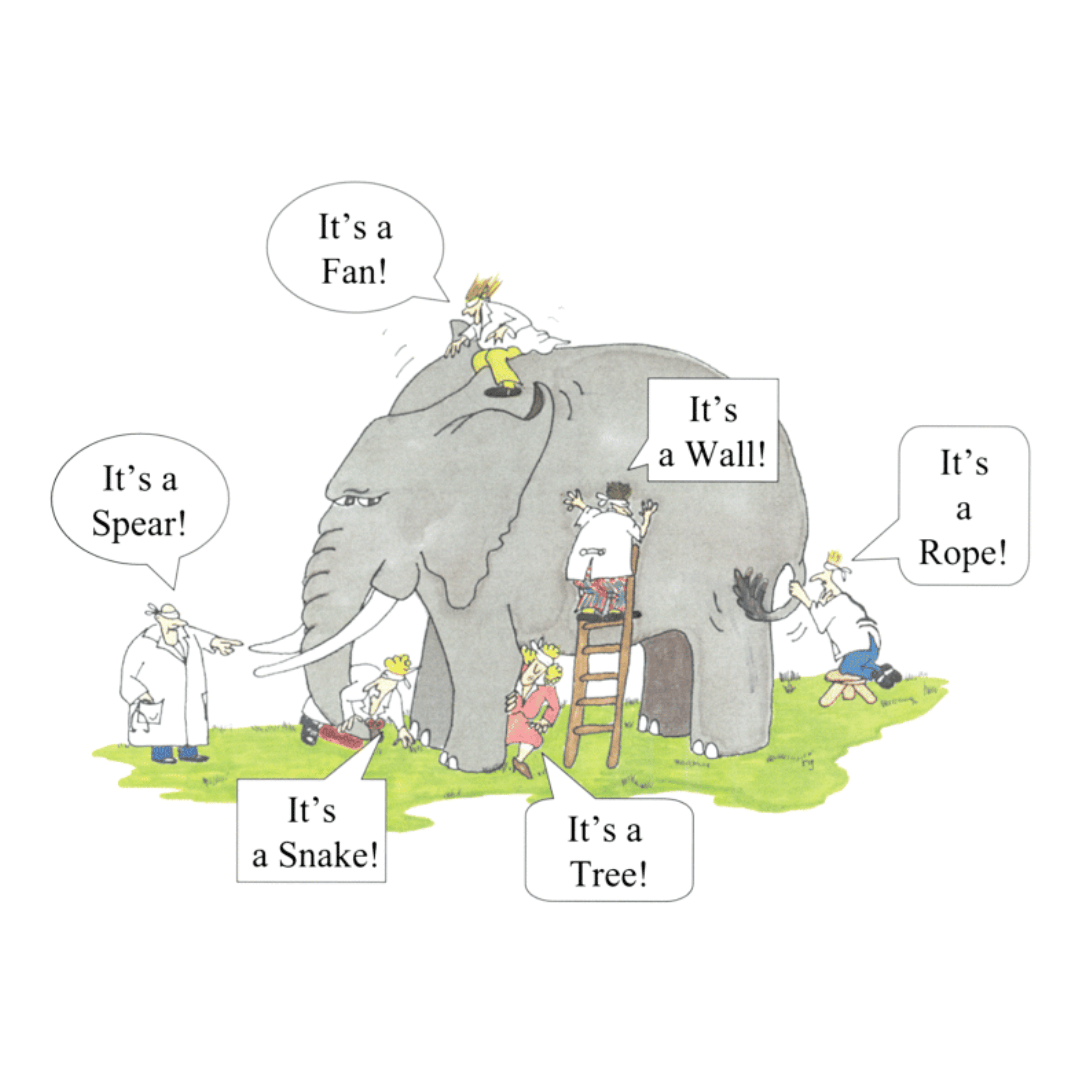At one time or another, we all suffer from a form of blindness; not a physical one, but an inability to step back and see the bigger picture. We become so comfortable and confident in our own perception, shaped by our unique experiences, that we struggle to believe there could be other valid ways to view a situation or problem. This “perception blindness” can significantly hinder effective decision-making and collaboration within any organization.
The Timeless Parable: Six Blind Men and an Elephant
The old Indian fable of the six blind men and the elephant, perhaps best captured in John Godfrey Saxe’s poem, perfectly illustrates this challenge:
It was six men of Indostan
To learning much inclined,
Who went to see the Elephant
(Though all of them were blind),
That each by observation
Might satisfy his mind.The First approached the Elephant,
And happening to fall
Against his broad and sturdy side,
At once began to bawl:
“God bless me! but the Elephant
Is very like a WALL!”The Second, feeling of the tusk,
Cried, “Ho, what have we here,
So very round and smooth and sharp?
To me ’tis mighty clear
This wonder of an Elephant
Is very like a SPEAR!”The Third approached the animal,
And happening to take
The squirming trunk within his hands,
Thus boldly up and spake:
“I see,” quoth he, “the Elephant
Is very like a SNAKE!”The Fourth reached out an eager hand,
And felt about the knee
“What most this wondrous beast is like
Is mighty plain,” quoth he:
“‘Tis clear enough the Elephant
Is very like a TREE!”The Fifth, who chanced to touch the ear,
Said: “E’en the blindest man
Can tell what this resembles most;
Deny the fact who can,
This marvel of an Elephant
Is very like a FAN!”The Sixth no sooner had begun
About the beast to grope,
Than seizing on the swinging tail
That fell within his scope,
“I see,” quoth he, “the Elephant
Is very like a ROPE!”And so these men of Indostan
Disputed loud and long,
Each in his own opinion
Exceeding stiff and strong,
Though each was partly in the right,
And all were in the wrong!
Too often in business, we become entrenched in our own position, convinced we’re dealing with a “spear,” a “wall,” or a “rope,” unable to see the entire “elephant in the room.” As leaders, it’s our responsibility to help our teams step back from these individual perceptions, explore other viewpoints, and build a shared understanding of the whole picture. This is particularly critical when navigating complex strategic initiatives, such as technology implementations or digital transformations, where different departments might initially have very different, and equally valid, yet incomplete, perspectives.

Bridging the Gap: The Leader’s Role in Fostering Holistic Understanding
But how do we guide our teams (and ourselves) when someone is stuck seeing only the “trunk”? The key lies in building a bridge from their current perception to a broader one. In terms of Emotional Intelligence for leadership, this means:
- Empathize and Validate: First, strive to genuinely understand why someone sees the situation as they do. “Cross the bridge” to their viewpoint. Acknowledge the validity of their experience of their “part of the elephant.” This builds trust and shows you’ve taken the time to understand their perspective.
- Invite Exploration: With that trust established, gently invite them to “walk back across the bridge with you” to explore other parts of the elephant: other viewpoints, different data, the perspectives of other stakeholders.
- Facilitate Collective Understanding: By helping everyone share their “piece” and see how it connects to others, you enable the team to collectively build a more complete and accurate picture of the overall situation or “elephant.”
As a fractional CIO, a significant part of my role involves facilitating this kind of holistic understanding for Small and Medium-Sized Businesses (SMBs). For example, when considering a new Enterprise Resource Planning (ERP) system, the sales team might focus on its CRM capabilities (the “trunk”), finance on its reporting features (an “ear”), and operations on its inventory management (a “leg”). My job is to help everyone see how these pieces form a cohesive whole that serves the entire business, and to ensure the chosen solution is indeed the right “elephant” for their needs.
Overcoming Our Own Perception Blindness
When we find ourselves in situations where progress stalls due to conflicting views, we must also be conscious of our own potential perception blindness. We need to actively force ourselves away from the “leg” we might be clinging to and make an effort to understand the “spear,” “wall,” and “fan” viewpoints around the table. Only then can we truly grasp the reality of the “elephant” and guide our teams effectively.
What’s Next
Achieving a shared, holistic understanding of complex challenges and opportunities is fundamental to making sound strategic decisions and driving your SMB forward. By consciously working to overcome perception blindness, both our own and within our teams, we can foster better collaboration, more innovative solutions, and ultimately help our businesses “Succeed Sooner.”
Is your SMB sometimes hindered by siloed perspectives or “perception blindness” when tackling strategic initiatives or technology decisions? If you’re looking for a partner to help your team see the “whole elephant” and build a cohesive, aligned strategy, let’s connect with Succeed Sooner Consulting.


Leave a Reply